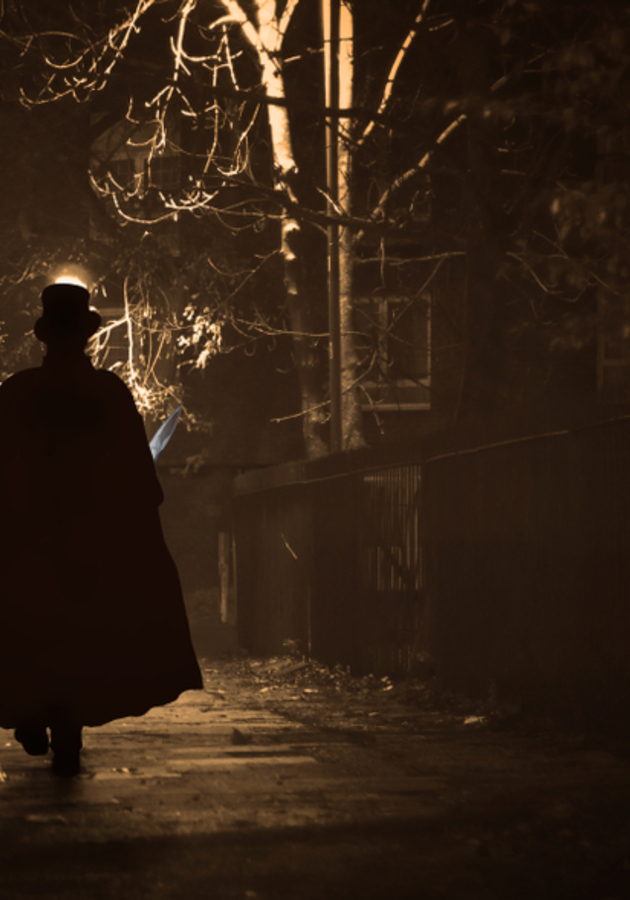In the autumn of 1888 – otherwise known as “the autumn of terror” – a series of horrendous murders occurred in the poor Whitechapel district of the East End of London. The murderer was never caught; to this day, he is known only by his gruesome nickname, Jack the Ripper. Yet, so many authors have tried revealing his identity since 1888, and he is featured so prominently in modern works of fact and fiction, that it sometimes feels as if one is born with intimate knowledge of the Whitechapel Murderer. Ironically, even though we know the names of all of his five canonical victims, we know hardly anything else about them.
Hallie Rubenhold, a British historian who specializes in 18th- and 19th-century social history, attempts to mend that in “The Five,” one of the very few books in history – if not the only one – that demonstrates genuine empathy and concern for the victims of Jack the Ripper. Indeed, Rubenhold’s intention in writing the book, in her own words, was “not to hunt and name the killer” but “to retrace the footsteps of five women, to consider their experiences within the context of their era, and to follow their paths through both the gloom and the light.” Get ready to join her on her quest!
Polly (August 26, 1845 – August 31, 1888)
Mary Ann Nichols – née Walker, and known to most of her friends as “Polly” – was born on August 26, 1845, in a dilapidated two-hundred-year-old house known as Dawes Court, and located at a dingy street, worthy enough to make an appearance in a Charles Dickens’ novel. Indeed, informs us Rubenhold, the author of “Oliver Twist” frequented the surrounding streets in his youth while working as a shoeblack and may have even based the lodgings of the fictional Fagin and his pickpocket boys on the real ones where Polly spent the first few years of her life.
At 18, Polly married a printer’s machinist named William Nichols, “a young man with a broad, sunny face and light hair.” Their marriage, however, would prove to be an unhappy one. Even though over the following decade and a half, Polly gave birth to five children, she and William argued a lot and by the time she had turned 35, they separated for good. It is impossible to know what lay at the heart of their arguments and what started them. During the separation proceedings, William claimed it was his wife’s “sudden affinity for drink.” Polly’s father, on the other hand, claimed that it was William’s unfaithfulness. Indeed, William was involved in an affair with a neighbor of the couple, a young widow named Rosetta Walls, who was also Polly’s nurse at the birth of her final child.
Whatever it was, Polly went back to live with her family, with the court awarding her a weekly maintenance of five shillings. William provided it for about a year, and then he simply stopped paying the money. In court, he produced skillfully gathered evidence of his wife’s “adultery without consent.” The judge seemed convinced enough to rule that William was now absolved of his financial responsibilities to Polly. In addition to losing the maintenance, Polly lost her good name as well – or whatever was left of it – by 1883. She was now deemed a prostitute.
According to Rubenhold, there is no evidence whatsoever that Nichols ever worked as a prostitute. In fact, in the spring of 1888, we know for a fact that she worked as a domestic servant for a religious family in Wandsworth. Unfortunately, her addiction to alcohol had spiraled out of control by then, and she left her employment in disrepute, stealing clothing worth several pounds. She spent the last few weeks of her life living in a common lodging-house in Spitalfields, before relocating to Whitechapel on August 24. A week later, she was viciously murdered by an unknown man. “Was she very cleanly in her habits?” the coroner asked a Spitalfields roommate of Polly at the inquest into her death. It didn’t matter that the roommate answered affirmatively. The police wanted a different story.
Annie (September 1841 – September 8, 1888)
Just a week after Polly’s severely mutilated body was discovered by a carman – who had mistaken it for a ragged tarpaulin – Londoners were shocked to hear of a similarly gruesome murder. The victim’s name was Annie Chapman. Her story was even sadder than that of Marry Ann Nichols. Once again, it’s a story of addiction. But it’s also a story of a young woman’s fall from grace.
Born in September 1841 to a soldier, Annie grew up in a better part of London, more specifically in the lodgings near the famous Hyde Park barracks. In the early summer of 1854, when Annie was merely a teenager, she watched all but one of her five siblings die of scarlet fever in the span of just three weeks. Somehow, her parents found enough strength in their hearts to move on. They even had two more children in the years that followed, two daughters named Georgina and Miriam. But for some reason, on June 13, 1863, Annie’s father thought he had seen too much of the world and decided to cut his throat with a razor. People speculated it might have been an alcohol-influenced, sorrow-laden decision. The coroners’ verdict was far more brutal: “suicide under temporary insanity.”
Six years after her father’s suicide, Annie married her mother’s lodger and relative, a gentleman’s coachman named John Chapman. Soon after, John was hired by a wealthy industrialist, so the couple moved to a cottage on his employer’s Berkshire estate. John had hoped the new house would keep Annie away from her favorite vice – rum, and for a while it really did. Unfortunately, the other challenge the couple had to face during their marriage made the battle for sobriety a difficult affair. Eventually, Annie lost – and with it, she lost herself.
You see, over the course of her marriage, Annie gave birth to eight children. Her first child, a daughter named Emily, seemed healthy as an infant, but by the age of eight, she began suffering from epileptic seizures. In the meantime, Annie began drinking again, so her second daughter lived just one day, and her third was born with what is now recognized as fetal alcohol syndrome. Annie’s next four children died in infancy, neither one of them living past their fourth month. The last of Annie’s children, a boy, was born paralyzed in 1880. By that time, Annie had reportedly overcome her alcohol dependency. However, her son’s disability hit her hard. So, when her eldest daughter Emily died from scarlet fever at her brother’s second birthday, Annie fell off the wagon, never to get back on it again.
In 1884, following an unsuccessful spell at a sanatorium, Annie was cast out by her husband from the couple’s house. She was homeless and sleeping on the street on September 8, 1888, when Jack the Ripper killed her before mutilating her abdomen. “What her murderer claimed on that night,” Rubenhold writes, “was simply all that remained of what the drink had left behind.”
Elisabeth (November 27, 1843 – September 30, 1888)
Elizabeth Stride, the Ripper’s only victim not to be mutilated, was born Elisabeth Gustafsdotter, on November 27, 1843, in a small village located roughly ten miles (16 kilometers) west of Gothenburg, Sweden. A farmer’s daughter, she was “initiated into the routines of agricultural life as soon as she was steady enough on her feet to carry pails and gather eggs.” At the age of 16, she chose to move to the city of Gothenburg in search of employment – and employment of a pretty specific type. “The golden ticket for working-class girls,” informs us Rubenhold, “was a life in domestic service, where it might become possible, after a number of years of back-breaking work, to rise in station and become a cook, a housekeeper, or a lady’s maid.”
Elisabeth got her golden ticket soon after relocation, but, unfortunately, at the same time she got something else as well: the reputation of a morally corrupt “fallen woman.” At the time, extramarital sex and illegitimate pregnancy had been punishable by law, and in March 1865, Elisabeth could no longer hide her pregnancy from her suspicious neighbors – or the police. At the end of the month, she was “ordered to appear at the first of what would become regular examinations of her genitalia by a surgeon at the police inspection house.” During one of these supposedly routine checks, on April 4, 1865, it was discovered that she had developed condyloma, or genital warts. The medical examiner knew this was an early symptom of syphilis so she had Elisabeth committed to the venereal disease hospital immediately. At the end of the month, Elisabeth gave birth to a stillborn seven-month-old girl. She refused to give the father’s name on the birth certificate.
In the winter of 1866, Elisabeth left Gothenburg for London where she learned to speak both English and Yiddish. Three years later, she married a ship’s carpenter named John Stride, 22 years her senior. At first happy, the couple’s marriage began deteriorating in 1874, and after a few on-again off-again stints, they permanently separated by the end of 1877, when John’s coffeehouse closed due to financial troubles. Subsequently, Elisabeth began supporting herself by posing as a disaster victim, claiming to have lost her husband and two of her nine children in the 1878 sinking of the Princess Alice in the River Thames.
With the money, she could afford nothing more than a place at London’s common lodging-houses – and maybe a bottle or two, here and there. In 1885, a year after her still-legal husband John died from tuberculosis, she took up residence with another man, Michael Kidney, a waterside laborer. Like Elisabeth, Michael too enjoyed drinking to excess and – as Rubenhold writes – “he was no less angry or violent than she was when intoxicated.” Twice in 1887, Elisabeth made complaints to the police about Kidney’s brutality, but she later dropped the charges. Following another argument, Elisabeth left Kidney on September 26, 1888. Four days later, she was killed by Jack the Ripper, less than one hour before he killed his fourth canonical victim, Catherine Eddowes.
Kate (April 14, 1842 – September 30, 1888)
Catherine Eddowes, known as Kate to her close ones, was born in Wolverhampton, but her family moved to London just a year after her birth. When she was just a teenager, both of her parents died, leaving her an orphan. After a brief period at a London orphanage, she returned to Wolverhampton to live with her aunt for a while, but then moved to Birmingham. In Birmingham, she met an Irish expatriate named Thomas Conway and fell madly in love with him. She even got his initials tattooed on her forearm. Conway did the same.
“No stranger to a nomadic existence” ever since his teens, Conway chose to earn his living as a chapman, hoping to earn money not only as a seller of books, but also as their writer. However, he had no means of achieving this aim because he was illiterate. Kate was not. Because he was the one with the stories and Kate the one with the ability to put them to paper, the two often worked together, arguing and singing ballad verses to themselves. “Under such circumstances,” Rubenhold argues, “it would be difficult to conceive that Kate did not have a hand in the composition of these works.”
Kate had already given birth to two children when the couple moved to London in 1868; soon after, a third child followed. By the late 1870s, Thomas had to leave London to find work, leaving Kate and his children without support. When he returned, he became violent. Even though the pair lived happily together “on a whole,” the quarrels between them became “difficult to ignore,” as Kate’s sisters remarked on one occasion. Moreover, the disagreements were exacerbated by Kate’s “habit of excessive drinking,” leading to the inevitable separation in 1880.
The following year, Kate rented a bed at a lodging house, wherein she met John Kelly, “the man who would come to fill Thomas Conway’s empty boots.” Although “quiet and inoffensive” when sober, Kelly was a heavy drinker – so he was rarely mild and pleasant. Even so, Kate remained with him all the way to her death which occurred in the early hours of September 30, 1888. A day before, Kate was found lying drunk on a street at the outskirts of London. When the police officer asked about her name later at the police station, Kate replied with a raspy, “Nothing.” That’s the name she was recorded under in the police report.
Mary Jane (c. 1863 – November 9, 1888)
Despite what she had said at the police station a day before she was murdered, Catherine Eddowes wasn’t nothing – she meant a lot to many people. In fact, despite numerous financial difficulties, the Eddowes family did everything they could to prevent Kate from being dropped into an unidentified pauper’s grave. Hundreds filled the streets for the funeral procession on October 8. At Ilford Cemetery, where Kate was eventually laid to rest, nearly five hundred people gathered to pay their respects. Just a month later, Jack the Ripper claimed his final victim: Mary Jane Kelly, a 25-year-old prostitute. Nobody came to claim her body, far more extensively mutilated than those of the other victims. Moreover, very few claimed to have known her.
One of these people was Joseph Barnett, “the nearest thing Mary Jane Kelly had to a family member.” He was both a former partner and a former roommate of Mary Jane. But even he never learned her true identity. She claimed to have been one of nine children and to have married, at the age of 16, to a Welsh coal miner named Davis, a few years after her father had taken the entire family to Carmarthen. After her husband’s supposed death in an explosion two years later, Mary Jane claimed to have gone to Cardiff and spent “eight or nine months in the infirmary.” If we are to believe her stories, then she fell in with a cousin “who followed a bad life” and who drew her into a life of prostitution.
Either way, at some time around 1884 – if not earlier – Mary Jane came to London and lived in “a gay house” in the West End of the town. One of the brothel’s most popular girls, she earned enough to buy herself expensive clothes and even rent out a carriage a few times. However, a series of setbacks brought her from the West End to the East End where she exchanged her hopes of a better life for a life in relative poverty. She did earn enough to move into a small single room in early 1888, but Barnett visited her on an almost daily basis during the last days of her life, occasionally giving her money. That was the room Mary Jane was killed in, the only one of Jack the Ripper’s victims not to be murdered outdoors.
The setting gave the killer enough time to eviscerate her body beyond recognition – and he probably spent over two hours performing the mutilation. Even so, following Mary Jane’s death, her body was placed in an open hearse, “a polished oak-and-elm coffin decorated with two floral wreaths and a cross of heartseed.” As Rubenhold notes, the funeral procession became “a show of defiance,” with men even removing their hats as she passed by. “God forgive her!” they were said to have cried out. “We will not forget her!” Ironically, they knew so little of her they had nothing to forget at all.
“Vicious inhabitants”
Shortly after the death of Annie Chapman, Mr. Edward Fairfield – a senior civil servant at Her Majesty’s Colonial Office – expressed his concern about the Whitechapel murders in a carefully worded letter sent to The Times and published by the newspaper just before Elisabeth and Kate’s deaths. The actual deaths of “the vicious inhabitants” of the poor streets of London were not what was bothering him. Amazingly enough, as Rubenhold remarks, “Fairfield was far more anxious that in the wake of this disturbance, women like Annie Chapman would be displaced from their hellish hovels […] and make their way into his neighborhood, carrying their ‘taint to the streets hitherto untainted.’”
As shocking as this might sound to you, you’d be even more shocked to learn that Fairfield didn’t stop there. It was a “good thing,” he went on, that these women “fell in with the unknown surgical genius,” because if they had no right to hire shelter, then they were probably merely prostitutes, women with tainted character, a fact that should make the acts of the murderer pretty much justified. “He, at all events,” Fairfield concluded, “has made his contribution towards solving the problem of clearing the East-end of its vicious inhabitants.”
“While today we are likely to shiver at such a comment,” notes Rubenhold, the truth is that “the story of Jack the Ripper is a narrative of a killer’s deep, abiding hatred of women, and our culture’s obsession with the mythology serves only to normalize its particular brand of misogyny.” The deeper, even more overwhelming truth is that the lives of the Ripper’s victims were neither simple to be disregarded nor unworthy of a poignant eulogy. Appallingly, they had to wait a full century for it, a period during which their murderer attained a mythological and almost iconic status. “In order to keep him alive,” reproaches Rubenhold, “we have had to forget his victims. We have become complicit in their diminishment.” In fact, we remember them only for what they weren’t: prostitutes.
“Just prostitutes”
What Polly, Annie, Elisabeth, Kate, and Mary Jane had in common wasn’t the thing everybody supposes they had. Namely, even though Victorian newspapers and most modern encyclopedias describe Jack the Ripper as “a killer of prostitutes,” three of his canonical victims were never involved in sex work. In fact, only one, Mary Jane Kelly, was recorded as a “prostitute” on her death certificate. The other four, under the field “occupation or profession,” were described as “wives,” “a widow” and “a supposed single woman.” They were all poor and homeless, they were all struggling with alcoholism and depression, and they were all asleep when attacked. Perhaps most importantly, they were – to use two words common for the age – “tainted women.”
And that’s what the real story is about, isn’t it? “The cards were stacked against Polly, Annie, Elisabeth, Kate, and Mary Jane from birth,” remarks Rubenhold. “They began their lives in deficit. Not only were most of them born into working-class families; they were also born female. Before they had even spoken their first words or taken their first steps, they were regarded as less important than their brothers and more of a burden on the world than their wealthier female counterparts. Their worth was compromised before they had even attempted to prove it.”
In a society wherein men were considered the family’s primary breadwinners, women were deemed, as if by definition, “expendable.” It didn’t matter that Kate and Polly were both literate – there was just not a suitable job for them. Not that it would have made any difference. Since poor women were considered expendable, women’s labor was quite cheap in the 19th century. In fact, a 12-hour shift at a factory could earn a woman nothing more than a bed and board. Simply put, 19th-century society was structured in such a manner that one of the very few ways for a single, husbandless or widowed woman to survive was as a prostitute. “But the victims of Jack the Ripper were never ‘just prostitutes,’” concludes Rubenhold. “They were daughters, wives, mothers, sisters, and lovers. They were women. They were human beings, and surely that in itself is enough.”
Final notes
According to Daisy Goodwin’s review for The Sunday Times, “The Five” is “a vividly written, carefully researched” book, one that “brings a whole new meaning to the phrase ‘Victorian values.’” But it is, in fact, more than that because it achieves what Hallie Rubenhold aims to achieve. Namely, in painting vividly the lives of Jack the Ripper’s five victims, the book gives back to them “that which was so brutally taken away with their lives: their dignity.”
Indeed, as Frances Wilson wrote in The Guardian, “The Five” “is not simply about the women who were murdered in Whitechapel in the autumn of 1888: it is for them.” Wilson is even more spot-on when she remarks, in the final sentence of her review, that Rubenhold’s is “a powerful and a shaming book, but most shameful of all is that it took 130 years to write.”
The same fact was pointed out by Rachel Cooke for The Observer. “Critics often describe books as 'long overdue',” Cooke wrote, “but few histories have arrived as late in the day as this one: you could fill a library with titles, serious and spurious, dedicated to so-called Ripperology, yet not one of them would cover this territory.” In doing so, as Kathleen Rooney remarked in The Star Tribune, “Rubenhold’s ‘The Five’ eloquently makes the case that while we will likely never know the identity of Jack the Ripper himself, we can and should understand and respect the identities of the individuals whose lives he took.”
In a word: exquisite. In two: highly recommended.
12min tip
If you liked “The Five” – or you consider yourself a fan of true crime novels – read our summary of “If You Tell” by Gregg Olsen, a true story of murder and family secrets in modern-day America.





























